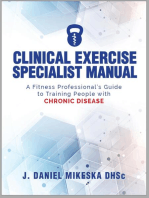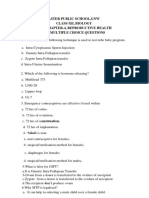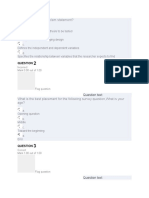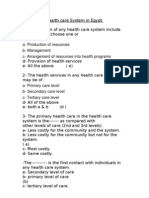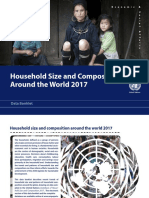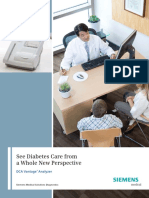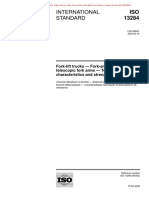Teaguebrf2 TB Ch01
Teaguebrf2 TB Ch01
Uploaded by
Luis-Patricia MillanCopyright:
Available Formats
Teaguebrf2 TB Ch01
Teaguebrf2 TB Ch01
Uploaded by
Luis-Patricia MillanOriginal Title
Copyright
Available Formats
Share this document
Did you find this document useful?
Is this content inappropriate?
Copyright:
Available Formats
Teaguebrf2 TB Ch01
Teaguebrf2 TB Ch01
Uploaded by
Luis-Patricia MillanCopyright:
Available Formats
Chapter 1 Health in a Changing Society Multiple Choice Questions 1. The primary goal of wellness is the ability to achieve A.
. freedom from disease. B. a multicultural view of health. C. the highest possible quality of life. D. greater control over lifestyle decisions. Answer: Page(s): Objective(s): 2. C 2 1
Which of the following is considered a social determinant of health? A. heredity B. lifestyle choices C. substance abuse D. the physical environment Answer: Page(s):3, 4 Objective(s): D 1
3.
Which of the following best demonstrates an ecological view of health and wellness? A. seeking a natural balance between your own life forces and those in your environment B. being aware of hereditary risks and avoiding unhealthy environments and behaviors C. going to the doctor whenever you suspect an illness D. seeking nontraditional medical treatments Answer: Page(s):3-4 Objective(s): B 1
4.
One of the hallmarks of community health promotion is its emphasis on improving A. common health-related resources. B. privately funded wellness programs. C. taxpayer-funded health initiatives. D. the regulation of hospitals and clinics. Answer: Page(s):4-5 Objective(s): A 1
5.
Which of the following best illustrates a public health measure? A. upgrading the local hospitals dialysis equipment
B. C. D.
preventing the spread of disease-carrying insects medical schools competing for research grants promoting a new surgical technique B 5 1
Answer: Page(s): Objective(s): 6.
The aspect of personal health that is most within your control is A. genetic inheritance. B. human biology. C. lifestyle. D. environment. Answer: Page(s): Objective(s): C 3, 8 1, 3
7.
Which of the following is one of the five basic criteria that describes culture in the health promotion context? A. physical characteristics B. technological status C. language D. politics Answer: Page(s): Objective(s): C 6 2
8.
Which of the following explanations for the poor health outcomes of ethnic minorities focuses on the lack of infrastructure to support health? A. acculturation theory B. risk exposure theory C. racial discrimination theory D. resource deprivation theory Answer: Page(s): Objective(s): D 7 2
9.
What model was developed in the 1950s to understand why people failed to take advantage of accessible and low-cost prevention programs? A. Transtheoretical Model B. Theory of Reasoned Action Model C. Health Belief Model D. Stages of Change Model
Answer: Page(s): Objective(s): 10.
C 8 3
In general, what can American ethnic minority populations expect concerning their health, as compared to the general population? A. lower lifestyle risk factors B. equal health benefits from medical advances C. higher rates of cancer, infant mortality, and alcoholism D. decreased exposure to carcinogens Answer: Page(s): Objective(s): C 7 2, 4
11.
Charlies sister lectures him daily about the threat that his smoking poses to his health. She argues that, if he quits, he would improve both his health and his athletic performance. Charlie knows his sister is right, but according to the Health Belief Model, he will only quit smoking if A. he thinks he can and that it will be worth the effort. B. others also criticize his smoking. C. his sister stops lecturing him. D. he has a serious health scare. Answer: Page(s):8 Objective(s): A 3
12.
The Transtheoretical Model (TTM) of health behavior change differs from the Health Belief Model in its emphasis on the A. need for change. B. stages of change. C. benefits of change. D. effectiveness of change. Answer: Page(s): Objective(s): B 9-10 3
13.
Mackenzie has resolved to start exercising three times a week when her membership at a local gym begins in two weeks. In which stage of change in the Transtheoretical Model is Mackenzie operating? A. contemplation B. action C. precontemplation D. preparation E. maintenance
Answer: Page(s): Objective(s): 14.
D 9 3
In which stage of change in the Transtheoretical Model does an individual intend to change a specific health behavior within the next six months? A. preparation B. contemplation C. maintenance D. precontemplation E. action Answer: Page(s): Objective(s): B 9 3
15.
Which of the following statements best illustrates a sense of self-efficacy? A. I should do it. B. I cant do it. C. I must do it. D. I can do it. Answer: Page(s): Objective(s): D 10 3
16.
The two major goals of Healthy People 2010 are to (1) increase life expectancies and life quality, and (2) A. decrease tobacco and alcohol use in all age groups. B. eliminate health disparities among different population groups. C. decrease binge drinking among college students. D. cut the incidence of accidental deaths in half by 2020. Answer: Page(s): Objective(s): B 7 2
17.
Which of the following best illustrates a SMART goal? A. I will get more exercise in the new year. B. I will avoid situations where I am tempted to eat junk food. C. I will make smart health choices in each major life activity. D. I will eat my meals on time and limit myself to one snack daily. Answer: Page(s): Objective(s): D 10 3
18.
What type of research study can suggest likely associations but cannot establish cause-and-effect relationships? A. correlational B. perspective C. retrospective D. experimental Answer: Page(s): Objective(s): A 12 4
19.
The purpose of making a clinical study double-blind is to A. guarantee the results. B. reduce researcher bias. C. disguise the studys sponsors. D. make the results depend on the outcomes of other studies. Answer: Page(s): Objective(s): B 12 4
20.
Which of the following statements is TRUE concerning medical research studies? A. Subjects are not randomly assigned to either a treatment group or control group. B. To be considered reliable results, the same results must be obtained by no other researchers conducting the same study. C. Researchers assign participants to either a treatment group or control group in order of when the participants register for the study. D. Clinical studies attempt to establish cause-and-effect relationships. Answer: Page(s): Objective(s): D 12 4
21.
The best type of website on which to do research on health issues is one that is sponsored by a(n) A. commercial health organization. B. nonprofit political organization. C. educational institution. D. individual. Answer: Page(s): Objective(s): C 13 4
22.
Which of the following statements about health risks is FALSE? A. The definition of health risk is the probability or likelihood of an event occurring.
B. C. D.
A health risk is the probability of exposure to a hazard that can result in negative consequences. All health risks can be avoided. Health risks include factors such as age, gender, family history, income, and education. C 11 4
Answer: Page(s): Objective(s): 23.
The basic definition of health literacy refers to ones ability to A. navigate the health care system successfully. B. obtain and use health information. C. describe symptoms to a doctor. D. achieve maximum wellness. Answer: Page(s): Objective(s): B 11 4
24.
Advanced literacy, cognitive, and interpersonal skills that enable consumers to navigate the health care system are known as ____________ literacy. A. critical B. health C. functional D. interactive Answer: Page(s): Objective(s): D 11 4
25.
Basic reading and writing skills that enable consumers to follow health messages are known as ____________ literacy. A. critical B. health C. functional D. interactive Answer: Page(s): Objective(s): C 11 4
26.
Which statement is TRUE concerning the obesity epidemic in the United States? A. Fifty percent of children and adults are classified as overweight or moderately obese. B. People who are overweight at age 40 are likely to die sooner than people who are not overweight. C. Americans walk more today than they did 20 years ago.
D.
Physical inactivity and poor diets are not likely to overtake smoking as the leading cause of preventable death. B 13 4
Answer: Page(s): Objective(s): True/False Questions 27.
Health and wellness are conceptualized as having several domains, such as physical, mental, emotional, and spiritual domains. Answer: Page(s): Objective(s): True 2 1
28.
The terms disease prevention and health promotion mean the same thing. Answer: Page(s): Objective(s): False 5 1
29.
According to the risk exposure theory, minority communities are more likely than white communities to be exposed to environmental health risks. Answer: Page(s): Objective(s): True 7 2
30.
Factors such as income level, available health care services, and literacy are examples of social determinants of health. Answer: Page(s): Objective(s): True 3 1
31.
In the United States, poor health outcomes are associated with environmental pollution, low educational attainment, and poverty. Answer: Page(s):4 Objective(s): True 1
32.
Ethnicity is synonymous with race.
Answer: Page(s): Objective(s): 33.
False 6 2
Advances in medical technology, lifestyle improvements, and environmental protection have produced significant and equal health benefits for most American ethnic populations. Answer: Page(s): Objective(s): False 6 2
34.
The slogan healthy people in healthy communities accurately expresses the goals of Healthy People 2010. Answer: Page(s): Objective(s): True 8 2
35.
A major assumption underlying most theory-based models for health behavior choices and change is that people usually gravitate toward unhealthy lifestyles. Answer: Page(s): Objective(s): True 8-9 3
36.
The Health Belief Model was developed in the 1950s in an effort to understand why people failed to take advantage of disease prevention or detection programs. Answer: Page(s): Objective(s): True 8 3
37.
The Health Belief Model is a more useful and accepted framework than the Transtheoretical Model for understanding health behavior change is. Answer: Page(s): Objective(s): False 8-9 3
38.
In the maintenance stage of the Transtheoretical Model for health behavior change, a new behavior has been in place for more than two years. Answer: Page(s): Objective(s): False 9 3
39.
For some types of health problems, such as alcohol addiction, few people reach the termination stage of the Transtheoretical Model. Answer: Page(s): Objective(s): True 9 3
40.
Activities such as developing social support systems and establishing goals and rewards help people to move through the stages of change in the Transtheoretical Model. Answer: Page(s): Objective(s): True 10-11 3
41.
Your behavior change plans must include strategies for dealing with potential barriers to change. Answer: Page(s): Objective(s): True 10 3
42.
For a person to change a behavior successfully, he or she does not necessarily have to have efficacy expectations about making the change. Answer: Page(s): Objective(s): False 10 3
43.
Behavior change contracts are among the most effective tools for change. Answer: Page(s): Objective(s): True 10 3
44.
Most people are motivated more by the long-term benefits of health behavior change than by the short-term benefits. Answer: Page(s): Objective(s): False 10-11 3
45.
The most important factor influencing health behavior change is commitment to change. Answer: True
Page(s): Objective(s): 46.
10 3
Cultural values have little influence on health. Answer: Page(s): Objective(s): False 6-7, 11 2, 4
47.
Early public health programs were created mainly to combat chronic degenerative illnesses. Answer: Page(s): Objective(s): False 5 1
48.
Healthy People 2010 includes a focus on community responsibility. Answer: Page(s): Objective(s): True 7 2
49.
Scientists typically consider the results of a single study to be conclusive and definitive. Answer: Page(s): Objective(s): False 12 4
50.
Three of the top ten current health concerns in the United States are substance abuse, immunization, and mental health. Answer: Page(s): Objective(s): True 13 4
51.
In the future, we can expect our society to face less-complex health questions, largely as a result of technological advances. Answer: Page(s): Objective(s): False 12-13 4
Short Answer Questions
52.
___________________ is generally defined as the process of adopting patterns of behavior that can lead to improved health and life satisfaction. Answer: Page(s): Objective(s): Wellness 2 1
53.
The sense of identity that individuals draw from a common ancestry, as well as a common national, religion, tribal, language, or cultural origin, is referred to as __________________. Answer: Page(s): Objective(s): ethnicity 6 2
54.
In the Transtheoretical Model, a person intends to change a specific health behavior within the next six months in the ___________________ stage. Answer: Page(s): Objective(s): contemplation 9 3
55.
In the Transtheoretical Model, a sixth stage called _________________ occurs when the new behavior is firmly entrenched in a persons lifestyle. Answer: Page(s): Objective(s): termination 9 3
56.
____________________ is an internal state in which a person feels competent to perform a task. Answer: Page(s): Objective(s): Self-efficacy 10 3
57.
Signing a ________________ change contract is one of the most effective strategies for change. Answer: Page(s): Objective(s): behavior 10 3
58.
The ________________ People initiative sets national health objectives aimed at improving the quality of life for all Americans. Answer: Page(s): Healthy 7
Objective(s): Matching Questions Match the following: A) B) C) D) E) 59.
wellness public health disease prevention health promotion community health
The study and practice of health promotion and disease prevention at the population level Answer: Page(s): Objective(s): B 5 1
60.
Actions taken to protect individuals from specific diseases Answer: Page(s): Objective(s): C 5 1
61.
Activities directed toward bettering the health of the public Answer: Page(s): Objective(s): E 4-5 1
62.
The process of adopting patterns of behavior that can lead to improved health and heightened life satisfaction Answer: Page(s): Objective(s): A 2 1
63.
Actions designed to maintain a current healthy state or to advance to a more desirable state Answer: Page(s): Objective(s): D 5 1
You might also like
- Population Health, Epidemiology, and Public Health: Management Skills for Creating Healthy Communities, Second EditionFrom EverandPopulation Health, Epidemiology, and Public Health: Management Skills for Creating Healthy Communities, Second EditionNo ratings yet
- MCQS Management PostrnDocument61 pagesMCQS Management PostrnAmina GulNo ratings yet
- MIDTERM Community Nursing 2Document24 pagesMIDTERM Community Nursing 2Will Garcia100% (4)
- 89333258Document20 pages89333258Luis-Patricia MillanNo ratings yet
- Health Policy ExamDocument17 pagesHealth Policy Exammuluken bizuayhuNo ratings yet
- FON Mcqs..-1Document2 pagesFON Mcqs..-1Rizwan Ejaz100% (1)
- CHN Practice TestDocument26 pagesCHN Practice Testdelacruz.mariacekeste0No ratings yet
- Group 13 HEALTH BELIEF MODEL (5 Points Quiz) - Multiple ChoiceDocument1 pageGroup 13 HEALTH BELIEF MODEL (5 Points Quiz) - Multiple ChoiceHEIDE BASING-A0% (1)
- A Client Comes To The WalkDocument5 pagesA Client Comes To The WalkNovelyn Kaye Ramos CalanogaNo ratings yet
- Leadership Mcqs PaperDocument6 pagesLeadership Mcqs PaperUmer Iqbal100% (1)
- Public - Health - Nursing - D6 - & - RM6 (1) - MCQDocument28 pagesPublic - Health - Nursing - D6 - & - RM6 (1) - MCQYussif Abdul FatawuNo ratings yet
- Nursing Process and Critical Thinking Review Test - ProProfs QuizDocument1 pageNursing Process and Critical Thinking Review Test - ProProfs QuizDeborah Rhoda AcheampongNo ratings yet
- Health Assessment Mid ExamDocument6 pagesHealth Assessment Mid ExamAddisu Sertsu100% (1)
- Multiple Choice QuestionsDocument5 pagesMultiple Choice QuestionsTyngkailinNo ratings yet
- Chapter 15 - Multiple ChoiceDocument12 pagesChapter 15 - Multiple ChoiceNicky PhakathiNo ratings yet
- Multiple Choice QuestionsDocument222 pagesMultiple Choice QuestionsKafui AugustineNo ratings yet
- FON-II All Chapter MCQs by Elite Nursing PlatformDocument52 pagesFON-II All Chapter MCQs by Elite Nursing Platformbhattisohaib610No ratings yet
- FON Important MCQsDocument27 pagesFON Important MCQsMuhammad SajjadNo ratings yet
- BSN-IV English-VII Sem-VII MCQ (B)Document6 pagesBSN-IV English-VII Sem-VII MCQ (B)Ali Qazi100% (1)
- Written Output in Module 4Document4 pagesWritten Output in Module 4Apple SangreNo ratings yet
- Multiple Choice Questions: Review of Preventive and Social MedicineDocument5 pagesMultiple Choice Questions: Review of Preventive and Social MedicineDr-Sanjay SinghaniaNo ratings yet
- Paper 2 - NCK Review of Questions (1) BBDocument111 pagesPaper 2 - NCK Review of Questions (1) BBjimwaoNo ratings yet
- Class 12 Chapter 4 Reproductive HealthDocument5 pagesClass 12 Chapter 4 Reproductive HealthSaransh KumarNo ratings yet
- BSN FON Values Belief Test 2 JIMSDocument5 pagesBSN FON Values Belief Test 2 JIMSpriya0% (1)
- Multiple Choice Questions: (Aiims Nov 1993) (DNB 2003)Document3 pagesMultiple Choice Questions: (Aiims Nov 1993) (DNB 2003)Dr-Sanjay SinghaniaNo ratings yet
- Quiz On ANPDocument9 pagesQuiz On ANPBhawna JoshiNo ratings yet
- HSM Lecture Notes by DR Mesfin A.Document91 pagesHSM Lecture Notes by DR Mesfin A.kasahailu04No ratings yet
- A Good Qualitative Problem Statement?: Incorrect Mark 0.00 Out of 1.00Document12 pagesA Good Qualitative Problem Statement?: Incorrect Mark 0.00 Out of 1.00Zainab MehfoozNo ratings yet
- Haramaya University Collage of Health and Medical Sciences School of Public Health MPH Entrance Exam/ 2020Document15 pagesHaramaya University Collage of Health and Medical Sciences School of Public Health MPH Entrance Exam/ 2020Mohammed AdusNo ratings yet
- CBTP DiagnosisDocument36 pagesCBTP DiagnosisAhmed Ebiso50% (2)
- Biostatistics & Research Methodology Mcqs 2024Document35 pagesBiostatistics & Research Methodology Mcqs 2024funnymemesworld2023100% (1)
- Minimum Package of Service and Standards For Adolescent HealthDocument13 pagesMinimum Package of Service and Standards For Adolescent HealthAdeniyi Ademola Olaoluwa100% (1)
- Health Statistics Revision QuestionsDocument8 pagesHealth Statistics Revision Questionsvictor ogotNo ratings yet
- Kenya Medical Training CollegeDocument17 pagesKenya Medical Training CollegeFarxan Da Napolian BwoyNo ratings yet
- MCQ S Ethical PrinciplesDocument6 pagesMCQ S Ethical Principlesmarwii100% (1)
- Management Quiz 1Document10 pagesManagement Quiz 1Reema100% (2)
- THE ETHICS OF PUBLIC HEALTH SURVEILLANCE MCQsDocument2 pagesTHE ETHICS OF PUBLIC HEALTH SURVEILLANCE MCQsChaman Lal Karotia100% (1)
- Multiple Choice QuestionsDocument7 pagesMultiple Choice QuestionsTaran JOt100% (3)
- Health Promotion Test QuestionsDocument5 pagesHealth Promotion Test QuestionsAyesha khanNo ratings yet
- 2023 HND Public Health Set 1Document6 pages2023 HND Public Health Set 1Nsemi Nsemi100% (2)
- CHN MCQ Set 3Document14 pagesCHN MCQ Set 3Neenu RajputNo ratings yet
- MCQ 2 Mental HealthDocument2 pagesMCQ 2 Mental HealthSUSUANNA SAFO100% (1)
- FIRST AID QUESTIONS at Original NewchapterDocument8 pagesFIRST AID QUESTIONS at Original NewchapteremmanuelmascotNo ratings yet
- Post-Rn 2nd Semester Epidemiology McqsDocument108 pagesPost-Rn 2nd Semester Epidemiology Mcqssurgicalincisions962No ratings yet
- Lahore School of Nursing LSNDocument4 pagesLahore School of Nursing LSNMuqaddas Rani100% (1)
- Set 2Document10 pagesSet 2babu singhNo ratings yet
- SW 151 Study GuideDocument20 pagesSW 151 Study GuidegcodouganNo ratings yet
- CHN MCQ Set 2Document15 pagesCHN MCQ Set 2Neenu RajputNo ratings yet
- McqsDocument6 pagesMcqsPinkymekala Hasanparthy100% (1)
- Self-Assessment Questions Chapter 14 ImmunityDocument9 pagesSelf-Assessment Questions Chapter 14 ImmunityShahd MohamedNo ratings yet
- Biostatistics 6th Semester BSN Notes, Educational PlatformDocument401 pagesBiostatistics 6th Semester BSN Notes, Educational PlatformFaisal khan AfridiNo ratings yet
- Concept of disease MCQs فراسDocument5 pagesConcept of disease MCQs فراسHisokagen100% (1)
- N.Theory - Solve MCQsDocument9 pagesN.Theory - Solve MCQshabibghumman8100% (1)
- UNIT 2 Nutrition Consideration in Infancy Preschool Years by TA SERIES.Document15 pagesUNIT 2 Nutrition Consideration in Infancy Preschool Years by TA SERIES.Abdul Hameed KhanNo ratings yet
- The Prehistory of Psychiatry in EthiopiaDocument3 pagesThe Prehistory of Psychiatry in EthiopiaifriqiyahNo ratings yet
- MCQDocument22 pagesMCQSandra Maged100% (3)
- Edward Jenner and The History of Vaccination MCQsDocument3 pagesEdward Jenner and The History of Vaccination MCQsMahi ShafiqueNo ratings yet
- MCQs For Professor SirDocument6 pagesMCQs For Professor SirnadiaNo ratings yet
- Practise Exam Paper - PH 106 - Introduction To Public HealthDocument6 pagesPractise Exam Paper - PH 106 - Introduction To Public Healthanniekawawa202No ratings yet
- Gradient RSSI Filter and Predictor For Wireless Networks Algorithms and ProtocolsDocument26 pagesGradient RSSI Filter and Predictor For Wireless Networks Algorithms and ProtocolsLuis-Patricia MillanNo ratings yet
- Trying To Find If I Can Find Significant Sources That Have A Variety of Views, I Don't Want A Boring Binary Views. Im Going To CheckDocument1 pageTrying To Find If I Can Find Significant Sources That Have A Variety of Views, I Don't Want A Boring Binary Views. Im Going To CheckLuis-Patricia MillanNo ratings yet
- Choosemyplate Recommendations and Results Worksheet (Bring This Sheet To Class)Document5 pagesChoosemyplate Recommendations and Results Worksheet (Bring This Sheet To Class)Luis-Patricia MillanNo ratings yet
- PHY 213 Homework (& Answers To Even Problems) : QuestionsDocument1 pagePHY 213 Homework (& Answers To Even Problems) : QuestionsLuis-Patricia MillanNo ratings yet
- Reed Multivariable CalculusDocument499 pagesReed Multivariable CalculusMrDubsterNo ratings yet
- Intro To AnalysisDocument268 pagesIntro To AnalysisLuis-Patricia MillanNo ratings yet
- Math Lab 1Document7 pagesMath Lab 1Luis-Patricia MillanNo ratings yet
- WritingDocument7 pagesWritingLuis-Patricia MillanNo ratings yet
- Questionnaire On TeachersDocument8 pagesQuestionnaire On TeachersRonavlau LauganasNo ratings yet
- Tbscript en ManualDocument44 pagesTbscript en ManualJuniowaNo ratings yet
- Pega Robotics: Robotic Process Automation: RPA Uses Unattended Robots Replicating 100% of AlgorithmicDocument47 pagesPega Robotics: Robotic Process Automation: RPA Uses Unattended Robots Replicating 100% of AlgorithmicSNo ratings yet
- Barricading Work Risk AssessmentsDocument1 pageBarricading Work Risk AssessmentsHSE1 SHAMNETNo ratings yet
- Fever, Jaundice and Hepatitis: It Is Not Always A Viral InfectionDocument7 pagesFever, Jaundice and Hepatitis: It Is Not Always A Viral Infectionshaznay delacruzNo ratings yet
- From Veil Theology To Face PDFDocument64 pagesFrom Veil Theology To Face PDFHugo MartinNo ratings yet
- Household Size and Composition Around The World 2017: Data BookletDocument36 pagesHousehold Size and Composition Around The World 2017: Data BookletCompetitii SportiveNo ratings yet
- 24 - Mitel EX Controller Mitel GX Gateway and TA7100 - Installation and ConfigurationDocument47 pages24 - Mitel EX Controller Mitel GX Gateway and TA7100 - Installation and ConfigurationCristhian HaroNo ratings yet
- DCA Vantage Brochure PDFDocument4 pagesDCA Vantage Brochure PDFmoutasim mohammadNo ratings yet
- Instant Access To Frankly in Love 1st Edition David Yoon (David Yoon) Ebook Full ChaptersDocument62 pagesInstant Access To Frankly in Love 1st Edition David Yoon (David Yoon) Ebook Full Chaptersmicheulymer82100% (12)
- Assignment - Bed Shampoo - Bed Bath-FernandezDocument3 pagesAssignment - Bed Shampoo - Bed Bath-FernandezVeronica ShaneNo ratings yet
- Procurement EthicsDocument18 pagesProcurement EthicsReynan GuerreroNo ratings yet
- Digital Logic Design Laboratory Manual: ObjectiveDocument8 pagesDigital Logic Design Laboratory Manual: ObjectiveDawit Adane KebedeNo ratings yet
- Hardware Requirements and Installation of Server 2008Document14 pagesHardware Requirements and Installation of Server 2008AbhyNo ratings yet
- Red Hat Enterprise Linux-8-8.4 Release Notes-En-USDocument160 pagesRed Hat Enterprise Linux-8-8.4 Release Notes-En-USAnoopriyaNo ratings yet
- Micro - Plus: Industrial RangeDocument24 pagesMicro - Plus: Industrial Rangesljiva11No ratings yet
- W5S2 Relevant Costs For Decision-Making Seminar SolutionsDocument4 pagesW5S2 Relevant Costs For Decision-Making Seminar SolutionsGuzi OvidiuNo ratings yet
- ESC 1 Fundamentals of Music Part 1Document6 pagesESC 1 Fundamentals of Music Part 1Ivony ManluluNo ratings yet
- User Manual: RS485 Option BoardDocument19 pagesUser Manual: RS485 Option BoardThang Le QuyetNo ratings yet
- NUR 105 Basic Nursing Assistant Handbook 2013 2014Document48 pagesNUR 105 Basic Nursing Assistant Handbook 2013 2014Ronald AranhaNo ratings yet
- Zebra Scanner Update Utility V 1-00-0010 Release NotesDocument4 pagesZebra Scanner Update Utility V 1-00-0010 Release NotesederNo ratings yet
- Manual Torre Grua TC 5512Document159 pagesManual Torre Grua TC 5512Jesus CuadroNo ratings yet
- (Chapter 1) E-Government Survey 2024 1392024Document33 pages(Chapter 1) E-Government Survey 2024 1392024ferio.pristiawanNo ratings yet
- Us20100270669a1 - Surface Mount Package With Ceramic SidewallsDocument13 pagesUs20100270669a1 - Surface Mount Package With Ceramic SidewallsNosfe Matingli DiazNo ratings yet
- EXW P006 0000 CS SHC MT 00096 Method Statement For Landscaping Rev.0Document28 pagesEXW P006 0000 CS SHC MT 00096 Method Statement For Landscaping Rev.0Syed Umair HashmiNo ratings yet
- D 16 N Vahanas or VehiclesDocument9 pagesD 16 N Vahanas or Vehiclesfarzana25No ratings yet
- ECT and A/T Indicator, Engine ControlDocument26 pagesECT and A/T Indicator, Engine ControlTrương Công ĐạtNo ratings yet
- WLP - English 8 - Week 3 - 4Document7 pagesWLP - English 8 - Week 3 - 4Judith GuillermoNo ratings yet
- ISO - 13284 - EN - Forklift Extention PDFDocument6 pagesISO - 13284 - EN - Forklift Extention PDFArsénio MatolaNo ratings yet
- CS - Scheme - 2019-New-21-3-2021Document107 pagesCS - Scheme - 2019-New-21-3-2021Ankit Kumar jhaNo ratings yet




